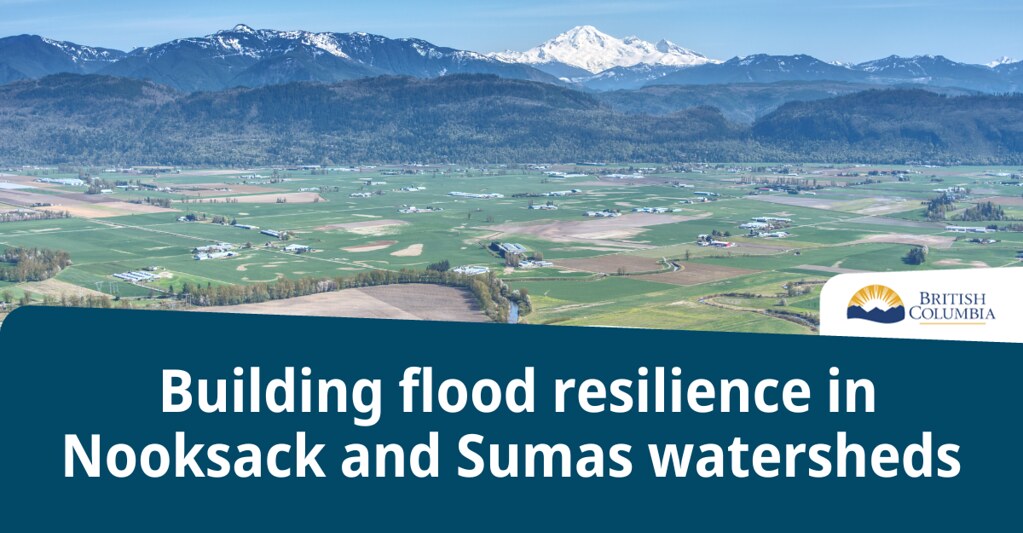
International agreement to build flood resilience in Nooksack, Sumas watersheds
October 23, 2023
By Government of BC
 Photo: Government of B.C.
Photo: Government of B.C. An international, multi-government agreement that commits to addressing flood risks and restoring salmon habitat in portions of British Columbia’s Fraser Valley and Washington state’s Whatcom County has been finalized.
The Transboundary Flood Initiative advances a collaborative framework to identify and pursue actions for flood-risk reduction and habitat restoration on the flood-prone Nooksack and Sumas watersheds.
The agreement was signed this week by representatives of nine governments – including B.C. Premier David Eby and Washington Gov. Jay Inslee – and by the Sumas, Matsqui and Leq’á:mel First Nations, the Nooksack Indian Tribe, Lummi Nation, the City of Abbotsford and Whatcom County, Wash.
“The atmospheric river event in November 2021 caused widespread damage and made it clear that collaboration with our southern neighbours is needed to prevent flooding and mitigate the risk of a similar climate disaster,” said Premier Eby. “By working together and combining our expertise, we can better protect people, their livelihoods and our communities.”
Gov. Inslee said: “The 2021 flooding devastated communities on both sides of the border and made clear we must plan for more disasters like this one fuelled by climate change. We must work collaboratively with Tribes and local governments on both sides of the border to comprehensively address flooding in the Nooksack and Sumas watersheds, restore salmon habitat, and build community capacity against climate change. I appreciate the leadership and commitment by all parties to work collaboratively on this vital issue.”
The initiative’s goals are to collaboratively manage the flood risk from the Nooksack and Sumas rivers, while restoring important habitat and ecosystem function for fish and other critical aquatic species, and to advance co-operation and collaboration with Indigenous governments. It will work collaboratively to evaluate flood hazard, share data and research, and leverage funding opportunities to advance flood-mitigation projects.
“The flooding issue in the Nooksack and Sumas river watersheds is decades old, but November 2021 highlighted the need to reduce the impact of such catastrophic flooding events in the future,” said Bowinn Ma, Minister of Emergency Management and Climate Readiness. “We know that climate change means we can expect these types of events to happen more frequently. That’s why this collaborative approach between neighbours is essential to finding long-term solutions.”
The Nooksack River flows through northern Washington state. When it overflows after heavy rains, it spills onto Sumas Prairie in B.C.’s Fraser Valley, which occurred during the atmospheric rivers of November 2021.
“Today marks an important co-operation between our governments to protect our communities and restore ecosystems,” said Sumas First Nation Chief Dalton Silver. “Semá:th embraces this as an opportunity to exercise our rights and fulfil our obligation to take care of S’ólh Téméxw – our land. We also look forward to working with all levels of government including the Nooksack, Lummi, Leq’á:mel, and Máthxwi peoples to protect our shared territories.”
The initiative has a three-tiered governance structure – leadership, policy and technical – which brings together people with specialized expertise to each table. The policy and technical experts have been meeting since September 2022. The first leadership meeting was held in June 2023 when the proposed framework was reviewed.
Together, the parties are working to:
- develop long-term solutions to address more frequent and severe flooding of the Nooksack River caused by climate change;
- bring together the necessary resources and relevant experts to help identify, evaluate and advance solutions;
- spearhead the design of projects and programs and identify sources of funding; and
- leverage opportunities for natural solutions that reduce flood risk and enhance habitat restoration.
Technical advancements addressing the Nooksack overflow risk to date include:
- strengthened monitoring and communication about Nooksack River conditions by B.C.’s River Forecast Centre and counterparts in Washington state; and
- expanded hydrologic modelling of the Nooksack and Sumas drainages and new flood-warning procedures for the Sumas River, utilizing information gleaned from the 2021 flood event.
In B.C., any flood-mitigation approaches and designs will align with the United Nations Declaration on the Rights of Indigenous Peoples and the Declaration on the Rights of Indigenous Peoples Act.
Print this page